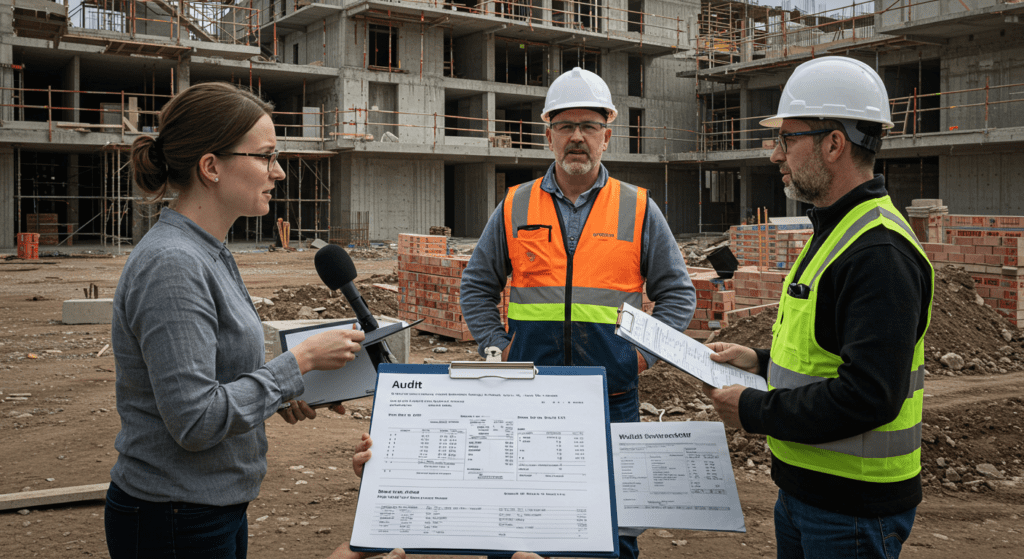- Key Documents and Records to Gather
- Common Audit Triggers in Construction
- Best Practices for Record Keeping
- Preparing Financial Statements and Worklogs
- Communicating with Your Insurance Provider
- Handling Discrepancies and Issues
- Steps to Mitigate Audit Risks
- Using Technology to Streamline Documentation
- Post-Audit Review and Continuous Improvement
An insurance audit is a routine review designed to verify the accuracy of insurance premiums by examining construction company records, worklogs, and financial statements. The process ensures that your reported information corresponds with actual work performed and past claims experience.
Audits can happen annually or at the end of a policy period, and may include on-site inspections, interviews, or requests for additional documentation. Understanding the audit process means knowing what an auditor is looking for, being aware of the timeline, and preparing your team ahead of time so adjustments can be made if discrepancies are uncovered.

1. Key Documents and Records to Gather
To ensure a smooth audit, it is vital to have easy access to all relevant documentation. Construction companies should compile requests and completed forms, such as project contracts, worker certifications, payroll records, invoices, material receipts, subcontractor agreements, and any previous audit results from other insurers.
Additionally, keep a well-organized file for certification of workers’ comp training and safety reports alongside equipment leases and maintenance logs. This collection of documents acts as the backbone of your audit and supports the data submitted in financial statements, helping auditors verify that all reported figures accurately reflect your operations
2. Common Audit Triggers in Construction
Construction is a complex industry with many moving parts. Several triggers could alert auditors to scrutinize your records further. Overtime expenses, fluctuating payroll ratios, high numbers of subcontractors compared to industry averages, and periods of rapid project expansion are all common audit triggers. Increases in claims or past incidents of workplace injuries in construction sites can also raise red flags.
Awareness of these triggers gives you the opportunity to monitor these risk areas continuously, enabling you to address any irregularities before an official audit is initiated. When unusual deviations from industry norms are noticed, proactive measures can help mitigate further scrutiny from both insurers and auditors.

3. Best Practices for Record Keeping
Maintaining accurate and accessible records is essential to a stress-free insurance audit. Best practices include implementing standardized procedures across all operating sites, using centralized documentation storage, and ensuring all departments are updated on record-keeping policies. Regular internal reviews help maintain organization and provide an audit trail that clearly shows compliance with industry standards.
Additionally, ensuring that everyone from the project manager to the site foreman understands the importance of immediate and accurate logging of work hours, equipment use, and material orders can minimize errors that may otherwise lead to costly discrepancies during an audit.
4. Preparing Financial Statements and Worklogs
For construction firms, financial statements and worklogs are critical to accurately assessing risk and determining insurance premiums. Financial statements should include detailed profit and loss reports, balance sheets, and cash flow statements that reflect all transactions. Worklogs must detail hours spent, project progress, and job-specific costs on each project.
These logs not only verify labor and resource allocation but also support payroll records and ensure that you report correct wage information to your insurance provider. Regularly updating these logs, reviewing them for mistakes, and reconciling them with financial statements provides a clearer and more precise picture of your business, which in turn helps you avoid unexpected adjustments during an audit.

5. Communicating with Your Insurance Provider
Establish a proactive communication line with your insurance provider well before an audit occurs. Regular check-ins can help identify potential discrepancies early, provide clarification on documentation requirements, and build trust between you and your insurer.
Explaining new projects, business expansions, or changes in work practices in advance can prevent misunderstandings during the audit process. By maintaining transparency about changes in project scope or workforce adjustments, you allow your insurer to align expectations and assist you with organizing data in preparation for the audit.
6. Handling Discrepancies and Issues
Errors or discrepancies can appear during an audit for a variety of reasons including miscommunication among team members, clerical errors, or differences in interpretations of work performed. When issues are discovered, address them immediately by reviewing records in detail and updating any incorrect information.
It is important to communicate discrepancies to your insurance provider transparently, and if needed, seek help from an independent auditor or an accountant who can facilitate corrections. Timely resolution of these issues demonstrates your company’s commitment to compliance and can improve the overall efficiency of the audit process

7. Steps to Mitigate Audit Risks
Reducing audit risks starts with proactive internal audits and staying informed about industry standards and regulatory changes. Start by conducting regular self-assessments to pinpoint vulnerabilities in your record-keeping and financial reporting systems. Incorporate risk management strategies such as segmented audits for different departments or projects, and create checklists for key documents that need to be updated throughout the project lifecycle.
Additionally, invest in ongoing education for personnel regarding compliance and best practices in worklog documentation. These proactive steps not only help mitigate audit risks but also reduce the potential for errors that could lead to increased premiums or claim discrepancies.
8. Using Technology to Streamline Documentation
Implementing technology solutions can transform how you prepare for an insurance audit. Digital record-keeping platforms, construction management software, and mobile applications for real-time worklog entry offer significant efficiencies. Cloud-based systems allow for secure storage and backup of essential files, ensuring that important documents are accessible from any location during an audit.
Sophisticated software options can integrate with existing financial systems to automatically generate reports, reconcile discrepancies, and facilitate rapid data retrieval. Embracing such innovation not only saves time but also minimizes the human error associated with manual record-keeping, leading to smoother and more accurate audits.

9. Post-Audit Review and Continuous Improvement
The conclusion of an audit is not the end of the probation of your systems and practices; it is an opportunity for thorough review and continuous improvement. Post-audit review sessions should include both your internal team and, where appropriate, your insurance provider to analyze what worked well and which areas need adjustment.
Use audit feedback to refine your record-keeping processes and document control systems. Incorporate improvements into routine training and future policy planning. By establishing a culture of continuous improvement, your company remains better prepared for subsequent audits, minimizes risk exposure, and enhances operational efficiency.

10. Conclusion
Preparing for an insurance audit in the construction industry may seem complex and burdensome, but utilizing these steps creates a structured approach to managing the entire process. Understanding the audit process, collecting all key documents, and being aware of common audit triggers can set the groundwork for compliance.
Further, strong record-keeping practices and precise preparation of financial statements and worklogs are crucial components that reflect the true state of your operations. Communication with your insurance provider and addressing discrepancies promptly show transparency and a commitment to fairness, reducing the overall friction during the audit.
Mitigating audit risks is significantly easier when you maintain an internal culture of accountability and continuously review your systems. Modern technology offers tools that not only streamline documentation but also ensure that data remains accurate and current, thus reducing the likelihood of audits triggering additional scrutiny.
When combined with a post-audit review process, these practices help create a self-correcting mechanism within your company that builds trust with your insurer and supports long-term business stability.
Successful navigation of an insurance audit is not just about responding to an external examination; it is about embedding best practices into the daily operations of your construction business. From day-to-day record keeping to thorough financial documentation, every aspect of your audit preparation should align with your overall goal of demonstrating transparency and reliability.
By following these guidelines, you can reduce the anxiety associated with potential audits and focus on growing your business while ensuring compliance with industry standards.
Every construction project and associated risk is unique, which underscores the importance of a customized approach to audit preparation. While templates and best practices provide a strong foundation, reviewing each project’s specific circumstances and adapting your internal processes is key.
Through ongoing education, technology adoption, and diligent record-keeping, your business not only prepares for audits more effectively but also builds a reputable legacy that reassures insurers, clients, and partners that you operate at the highest level of professionalism and accountability.
